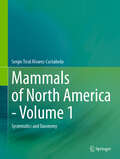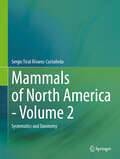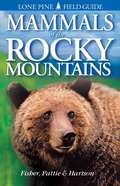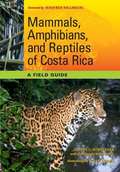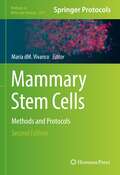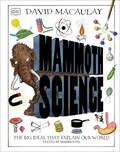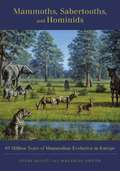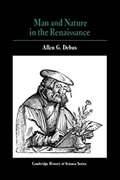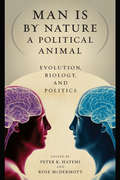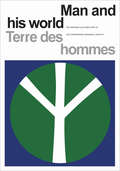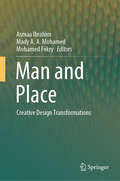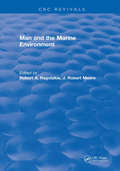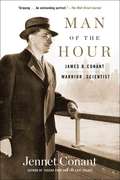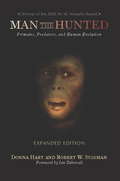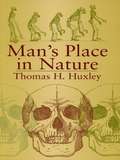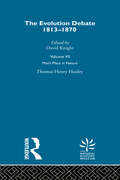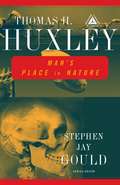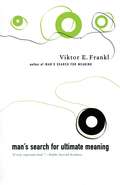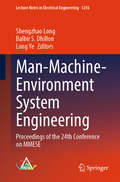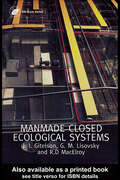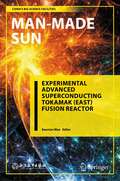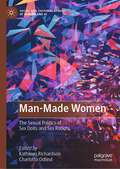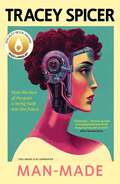- Table View
- List View
Mammals of North America - Volume 1: Systematics and Taxonomy
by Sergio Ticul Álvarez-CastañedaThe book synthesizes nomenclature, systematics, and descriptions of North American mammal species. Clear, simple and illustrated identification keys are provided to make knowledge of mammals easier and facilitate the training both students and professionals in the field, including readers without extensive experience. Descriptions of the different species are provided up to Order, highlighting the diagnostic features that allow identifying them promptly while the reader learns how to make subsequent identifications without having the book at hand. Each species comes with potential distribution maps based on existing records in the main museums of North America. The book includes the description, characteristics and distribution maps of the 781 species with range in the North America subcontinent
Mammals of North America - Volume 2: Systematics and Taxonomy
by Sergio Ticul Álvarez-CastañedaThe second volume of this book series synthesizes nomenclature, systematics, and descriptions of North American mammal species. Clear, simple and illustrated identification keys are provided to make knowledge of mammals easier and facilitate the training both students and professionals in the field, including readers without extensive experience. Descriptions of the different species are provided up to Order, highlighting the diagnostic features that allow identifying them promptly while the reader learns how to make subsequent identifications without having the book at hand. Each species comes with potential distribution maps based on existing records in the main museums of North America. The book includes the description, characteristics and distribution maps of the 781 species with range in the North America subcontinent
Mammals of Ungava and Labrador: The 1882-1884 Fieldnotes of Lucien M. Turner together with Inuit and Innu Knowledge
by Tim Flannery Scott A. Heyes Bryony Anderson Kristofer M. HelgenIn 1882 the Smithsonian Institution Arctic scientist, Lucien McShan Turner, traveled to the Ungava District that encompasses Northern Quebec and Labrador. There he spent 20 months as part of a mission to record meteorological data for an International Polar Year research program. While stationed at the Hudson's Bay Company Trading Post of Fort Chimo in Ungava Bay, now the Inuit community of Kuujjuaq, he soon tired of his primary task and expanded his duties to a study of the natural history and ethnography of the Aboriginal peoples of the region. His ethnography of the Inuit and Innu people was published in 1894, but his substantial writings on natural history never made it to print. Presented here for the first time is the natural history material that Lucien M. Turner wrote on mammals of the Ungava and Labrador regions. His writings provide a glimpse of the habits and types of mammals that roamed Ungava 125 years ago in what was an unknown frontier to non-Inuit and non-Innu people.
Mammals of the Rocky Mountains
by Chris Fisher Don Pattie Tamara HartsonThis fascinating and readable textbook describes these mammals in detail-what they look like, what they eat, where they live, what they like to do. Since otters intrigue me, here's a sample from the pages about them. Northern River Otter Lontra canadensis It may seem to be too good to be true, but all those playful characterizations of the Northern River Otter are founded on truth. Otters often amuse themselves by rolling about, sliding, diving or "body surfing," and they may also push and balance floating sticks with their noses or drop and retrieve pebbles for minutes at a time. They seem particularly interested in playing on slippery surfaces-they leap onto the snow or mud with their forelegs folded close to their bodies for a streamlined toboggan ride. Unlike most members of the weasel family, river otters are social animals, and they will frolic together in the water and take turns sliding down banks. With their streamlined bodies, rudder-like tails, webbed toes and valved ears and nostrils, river otters are well adapted for aquatic habitats. Even when they emerge from the water to clamber over rocks, there is a serpentine appearance to their progression. The large amounts of playtime they seem to have results from their efficiency at catching prey when it is plentiful. Although otters generally cruise along slowly in the water by paddling with all four feet, they can sprint after prey with the ease of a seal whenever hunger strikes. When an otter swims quickly, it chiefly propels itself with vertical undulations of its body, hindlegs and tail. Otters can hold their breath for as long as five minutes, and, if so inclined, they could swim the breadth of a small lake without surfacing. ... In the past, the Northern River Otter's thick, beautiful, durable fur led to excessive hunting. This file should make an excellent embossed braille copy.
Mammals, Amphibians, and Reptiles of Costa Rica
by Carrol L. HendersonTo help visitors, as well as local residents, identify and enjoy the wildlife of Costa Rica, Carrol L. Henderson published Field Guide to the Wildlife of Costa Rica in 2002, and it instantly became the indispensable guide. Now Henderson has created a field guide dedicated to the monkeys, sloths, treefrogs, lizards, crocodiles, and other animals that travelers are most likely to see while exploring the wild lands of Costa Rica. He includes fascinating information on their natural history, ecology, identification, and behavior gleaned from his forty years of travels, studies, and wildlife viewing in Costa Rica, as well as details on where to see these remarkable and beautiful creatures. The mammals, amphibians, and reptiles are illustrated by stunning and colorful photographs-most of which were taken in the wild by Henderson. A detailed and invaluable appendix that identifies many of Costa Rica's best wildlife-watching destinations, lodges, and contact information for trip-planning purposes completes the volume.
Mammary Stem Cells: Methods and Protocols (Methods in Molecular Biology #2471)
by Maria Dm. VivancoThis second edition provides an overview of recent developments and approaches used by researchers to investigate the properties and functions of mammary epithelial and stem cells, which will contribute to understand the heterogeneity of the mammary gland and of breast cancer. Chapters detail processes used to characterize stem cells, single cell RNA sequencing, computational methods, sophisticated imaging techniques, and a variety of model systems, among others. Written in the highly successful Methods in Molecular Biology series format, chapters include introductions to their respective topics, lists of the necessary materials and reagents, step-by-step, readily reproducible laboratory protocols, and tips on troubleshooting and avoiding known pitfalls. Authoritative and cutting-edge, Mammary Stem Cells: Methods and Protocols, Second Edition aims to make available protocols used to navigate the intricate behavior of mammary stem cells and to gain further knowledge to take us closer to the design of innovative strategies to prevent and treat breast cancer.
Mammoth Science: The Big Ideas That Explain Our World (DK David Macaulay How Things Work)
by DKDavid Macaulay's troupe of curious mammoths lead you through the basics of physics, biology, and chemistry in this unconventional and highly original guide to science.From the interior of an atom to the solar system and beyond, the mammoths seek to understand the science! These intrepid science demonstrators will go to incredible lengths to educate and entertain. They wrestle with magnets to understand their powerful force, make mammoth models of different materials explore what gives them mass, and step into an X-ray machine to reveal the bones beneath their woolly exterior.Observing and recording the mammoth's behavior is bestselling illustrator David Macaulay, whose How Machines Work won the Royal Society Young People's Book Prize in 2016. Renowned for his ability to explain complex ideas with simple genius, Macaulay captures the oddball humor of his subject matter, making Macaulay's Mammoth Science the perfect introduction to scientific principles for the young and the young-at-heart.
Mammoths and the Environment
by Valentina V. UkraintsevaThe study of fossilised remains of herbivorous animals, particularly those rare findings with well-preserved gastrointestinal tracts filled with plant remains, is crucial to our understanding of the environment in which they lived. Summarising thirty years of research, Ukraintseva presents evidence on plants once eaten by Siberia's major herbivorous mammals. The collection of pollen and plant spores from food remains sheds light on the vegetation of these ancient habitats, enabling researchers to reconstruct local floras of the time. This also promotes further insight into the causes of the extinction of various species due to changing environmental conditions and food availability. Providing a history of the research undertaken, the book also includes specific chapters on the Cherski horse and bison, along with the vegetation and climate of Siberia in the late Anthropogene period, making it a lasting reference tool for graduate students and researchers in the field.
Mammoths, Sabertooths, and Hominids: 65 Million Years of Mammalian Evolution in Europe
by Mauricio Antón Jordi AgustíMammoths, Sabertooths, and Hominids takes us on a journey through 65 million years, from the aftermath of the extinction of the dinosaurs to the glacial climax of the Pleistocene epoch; from the rain forests of the Paleocene and the Eocene, with their lemur-like primates, to the harsh landscape of the Pleistocene Steppes, home to the woolly mammoth. It is also a journey through space, following the migrations of mammal species that evolved on other continents and eventually met to compete or coexist in Cenozoic Europe. Finally, it is a journey through the complexity of mammalian evolution, a review of the changes and adaptations that have allowed mammals to flourish and become the dominant land vertebrates on Earth. With the benefit of recent advances in geological and geophysical techniques, Jordi Agustí and Mauricio Antón are able to trace the processes of mammalian evolution as never before; events that hitherto appeared synchronous or at least closely related can now be distinguished on a scale of hundreds or even dozens of thousands of years, revealing the dramatic importance of climactic changes both major and minor. Evolutionary developments are rendered in magnificent illustrations of the many extraordinary species that once inhabited Europe, detailing their osteology, functional anatomy, and inferred patterns of locomotion and behavior. Based on the latest research and field work, Mammoths, Sabertooths, and Hominids transforms our understanding of how mammals evolved and changed the face of the planet.
Man And Nature In The Renaissance (Cambridge Studies In The History Of Science Series)
by George Basalla Allen George Debus Owen HannawayMan and Nature in the Renaissance offers an introduction to science and medicine during the earlier phases of the scientific revolution, from the mid-fifteenth century to the mid-seventeenth century. Renaissance science has frequently been approached in terms of the progress of the exact sciences of mathematics and astronomy, to the neglect of the broader intellectual context of the period. Conversely, those authors who have emphasized the latter frequently play down the importance of the technical scientific developments. In this book, Professor Debus amalgamates these approaches: The exact sciences of the period are discussed in detail, but reference is constantly made to religious and philosophical concepts that play little part in the science of our own time. Thus, the renewed interest in mystical texts and the subsequent impact of alchemy, astrology, and natural magic on the development of modern science and medicine are central to the account. Major themes that are followed throughout the book include the effects of humanism, the search for a new method of science, and the dialogue between proponents of the mystical-occult world view and the mathematical-observational approach to nature.
Man Is by Nature a Political Animal: Evolution, Biology, and Politics
by Rose Mcdermott Peter K. HatemiIn Man Is by Nature a Political Animal, Peter K. Hatemi and Rose McDermott bring together a diverse group of contributors to examine the ways in which evolutionary theory and biological research are increasingly informing analyses of political behavior. Focusing on the theoretical, methodological, and empirical frameworks of a variety of biological approaches to political attitudes and preferences, the authors consider a wide range of topics, including the comparative basis of political behavior, the utility of formal modeling informed by evolutionary theory, the genetic bases of attitudes and behaviors, psychophysiological methods and research, and the wealth of insight generated by recent research on the human brain. Through this approach, the book reveals the biological bases of many previously unexplained variances within the extant models of political behavior.<P><P> The diversity of methods discussed and variety of issues examined here will make this book of great interest to students and scholars seeking a comprehensive overview of this emerging approach to the study of politics and behavior.
Man and His World/Terres des hommes: The Noranda Lectures, Expo 67/Les Conferences Noranda/L'Expo 67
by Helen Hogg The Noranda Lectures/ Expo 67The fruits of a unique cultural exchange are brought together in this unusual book. Twenty-eight of the most eminent men and women of our generation – philosophers, historians, and scientists from nineteen countries – here discuss what they consider the most vital issues of our day. Paul-Henri Spaak, Barbara Ward, Gunnar Mydral, Linus Pauling, and many others participated in the Noranda lecture series at Expo 67 in Montreal, and each is concerned here with a special aspect of Expo's theme: Man and His World. The approaches to the theme are as varied as the backgrounds of the speakers. Some of the essays give a revealing and optimistic description of the national and international efforts to ensure a future for mankind; others, less optimistic, stress the increasing insanity of the world and draw attention to the poverty, starvation, hatred, waste, and war which destroy what creative men have built. One group of papers deals with the idea of progress. André Leroi Gourhan offers a panoramic description of man's cultural evolution and sketches the vast possibilities of future development; Karl Löwith questions the very notion of progress and observes that much "progressive" development has resulted in nothing but destruction; Félix Houphouët-Boigny, president of the Ivory Coast Republic, describes progress in one section of the world – Africa, and the Ivory Coast in particular. Other lectures deal with such diverse topics as the proper role of government, the modern scientist, formal and informal aspects of education, the history of architecture, recent biological contributions of chemistry, the population explosion, new advances in physics, and the world as a separate entity from man. "The world as universe is not made by man," Professor Löwith reminds us. "It is there, even without us, existing for and by itself." Originally sponsored by Noranda Mines Ltd., the lectures attracted wide attention at the time of their delivery and again later when some of them were broadcast on radio and television. Collected in this book, they offer a distillation of some of the most significant thinking of today – clear and cogent presentations of ideas that have won Nobel prizes for some of their creators and international recognition for all. In her Introduction, Helen Hogg writes, "It is a book to be sipped and savoured, to be dipped into again and again. Such an approach will enable the reader best to appreciate the penetrating commentaries of some of the world's greatest figures."
Man and Place: Creative Design Transformations
by Asmaa Ibrahim Mohamed Fekry Mady A. A. MohamedThis book is a result of the 1st ARCH and DESN International Conference (previously Memaryat) Conference held at Effat university on the 8th and 9th of February 2023, and includes chapters dealing with the critical manifestation of “Man and Place” to accommodate and embrace social, economic, and environmental needs within a balanced, integrated system.The book is groundbreaking in that it brings together some of the brightest minds in academia and industry. The book includes a diverse range of contributions from esteemed academics and practitioners and offers a unique platform for thought-provoking discussions and innovative strategies that will help shape the cities of tomorrow.Further chapters include topics such as sustainability and creative transformations, smart cities, environmental resilience, resilient local economies, manufacturing innovations, and smart products. This book will be of interest to decision-makers, architects, interior designers, product designers, urban planners, urban designers, entrepreneurs, educators, and agencies.
Man and the Marine Environment
by RagotzkieMarine recreation represents one of the most important uses of our marine and coastal environments.This is a natural result of three things; population density in coastal areas, increasing interest in outdoor recreation, and the special lure of the sea.What the poet may think of as the lure of the sea, today‘s recreation planner would consider a combination of resource-directed and image-directed desires.
Man of the Hour: James B. Conant, Warrior Scientist
by Jennet ConantThe remarkable life of one of the most influential men of the greatest generation, James B. Conant—a savvy architect of the nuclear age and the Cold War—told by his granddaughter, New York Times bestselling author Jennet Conant.James Bryant Conant was a towering figure. He was at the center of the mammoth threats and challenges of the twentieth century. As a young eminent chemist, he supervised the production of poison gas in WWI. As a controversial president of Harvard University, he was a champion of meritocracy and open admissions. As an advisor to FDR, he led the interventionist cause for US entrance in WWII. During that war, Conant was the administrative director of the Manhattan Project, oversaw the development of the atomic bomb and argued that it be used against the industrial city of Hiroshima in Japan. Later, he urged the Atomic Energy Commission to reject the hydrogen bomb, and devoted the rest of his life to campaigning for international control of atomic weapons. As Eisenhower’s high commissioner to Germany, he helped to plan German recovery and was an architect of the United States’ Cold War policy. Now New York Times bestselling author Jennet Conant recreates the cataclysmic events of the twentieth century as her grandfather James experienced them. She describes the guilt, fears, and sometimes regret of those who invented and deployed the bombs and the personal toll it took. From the White House to Los Alamos to Harvard University, Man of the Hour is based on hundreds of documents and diaries, interviews with Manhattan Projects scientists, Harvard colleagues, and Conant’s friends and family, including her father, James B. Conant’s son. This is a very intimate, up-close look at some of the most argued cases of modern times—among them the use of chemical weapons, the decision to drop the bomb, Oppenheimer’s fate, the politics of post-war Germany and the Cold War—the repercussions of which are still affecting our world today.
Man the Hunted
by HartA provocative view of human evolution that contends early humans occupied a far more vulnerable position in the food chain than we like to imagine.
Man's Place in Nature
by Thomas H. HuxleyKnown as "Darwin's Bulldog" for his impassioned defense of evolutionary theory, Thomas Huxley published this, his most famous book, just a few years after Darwin's The Origin of the Species. Unlike Origin, this book focuses on human ancestry and offers a concise, nontechnical survey of the state of mid-nineteenth-century knowledge about primate and human paleontology and ethology.Man's Place in Nature concurs with Darwin's assertion of the absence of a physiologic and psychic structural line of demarcation between humans and apes. Huxley ventures further than Darwin, however, by making the first attempt to apply the principles of evolution directly to the human race (an issue that Darwin skirted). Despite Huxley's acknowledgements of the wide gulf represented by the human capacity for rational speech and language, some Victorian readers were scandalized by the application of Darwinian theory to humans and by Huxley's evidence of the fundamental similarities between the human brain and the ape brain. A landmark of scientific progress, this immensely readable book reflects the stylistic gifts that made its author a popular public speaker.
Man's Place in Nature, 1863: Man's Place In Nature, Volume Vii
by Thomas Henry HuxleyHuxley was one of the first adherents to Darwin's theory of evolution by natural selection and advanced its acceptance by scientists and the public. Man's Place in Nature was explicitly directed against Richard Owen, who had claimed that there were distinct differences between human brains and those of apes. Huxley demonstrated that ape and human brains were fundamentally similar in every anatomical detail, thus applying evolution to the human race.
Man's Place in Nature: And Other Anthropological Essays (classic Reprint) (Modern Library Science)
by Thomas Henry Huxley Stephen Jay GouldThomas Henry Huxley was one of the first supporters of Charles Darwin's theory of evolution by natural selection, and he did more than any other writer to advance its acceptance among scientists and nonscientists alike. His most famous book, Man's Place in Nature, published only five years after Darwin's The Origin of Species, offers a compelling review of primate and human paleontology, and is the first attempt to apply Darwin's theory to human beings. As compelling a piece of analysis now as it was 140 years ago, Man's Place in Nature is a must for every science lover's library.
Man's Search For Ultimate Meaning
by Viktor E FranklViktor Frankl, bestselling author of Man's Search for Meaning, explains the psychological tools that enabled him to survive the HolocaustViktor Frankl is known to millions as the author of Man's Search for Meaning, his harrowing Holocaust memoir. In this book, he goes more deeply into the ways of thinking that enabled him to survive imprisonment in a concentration camp and to find meaning in life in spite of all the odds. He expands upon his groundbreaking ideas and searches for answers about life, death, faith and suffering. Believing that there is much more to our existence than meets the eye, he says: 'No one will be able to make us believe that man is a sublimated animal once we can show that within him there is a repressed angel.'In Man's Search for Ultimate Meaning, Frankl explores our sometimes unconscious desire for inspiration or revelation. He explains how we can create meaning for ourselves and, ultimately, he reveals how life has more to offer us than we could ever imagine.
Man-Machine-Environment System Engineering: Proceedings of the 24th Conference on MMESE (Lecture Notes in Electrical Engineering #1256)
by Balbir S. Dhillon Shengzhao Long Long YeFrom this book reader will learn the best research topics and the latest development trend in MMESE theory and application. Man-Machine-Environment System Engineering (MMESE) is a scientific study on the design concepts and quantitative analysis of a complex giant system using physiology, psychology, system engineering, computer science, environment science, management theory, education, and other related disciplines methods. MMESE focuses mainly on the relationship and the optimum combination between Man, Machine, and Environment. The three optimized goals of the MMESE study are safety, efficiency, and economy. Researchers and professionals who study a human-centered interdisciplinary subject crossing above disciplines will be mostly benefited from this proceedings. In 1981 with direct support from one of the greatest modern Chinese scientists, Xuesen Qian, Man-Machine-Environment System Engineering (MMESE), the integrated and advanced science research topic was established in China by Professor Shengzhao Long. Man-Machine-Environment System Engineering: Proceedings of the 24th Conference on MMESE is the academic showcase of latest research papers selected from more than 500 submission in this field in 2024.
Man-Made Closed Ecological Systems
by J.I. Gitelson G.M. LisovskyProviding a broad historical perspective, this book explores the interactions between humans, microorganisms, and plants in a closed habitat, and the life support systems necessary to maintain habitability over long periods of time. Topics include the cultivation of bacteria, microalgae and higher plants; the use of biotechnology to support life outside the Earth's biosphere; methods for recycling air, water and food for human consumption; interactions between humans and other organisms in CMESs; and methods for intensifying the level of photosynthesis. In addition to space the authors investigate problems associated with living conditions in dangerous or difficult environmental areas on Earth such as the Arctic and Antarctica, deserts and mountains.
Man-Made Sun: Experimental Advanced Superconducting Tokamak (EAST) Fusion Reactor (China’s Big Science Facilities)
by Baonian WanThis book introduces the research process and principles of the controlled super-coupling nuclear fusion experiment at the Experimental Advanced Superconducting Tokamak (EAST) nuclear fusion reactor in Hefei, China. It uses straightforward language to explain how nuclear fusion can provide safe, environmentally friendly, clean, and inexhaustible energy in future. EAST is the world’s first fully superconducting, non-circular cross-section tokamak nuclear fusion experimental device, independently developed by the Chinese Academy of Sciences. This book helps demonstrate China’s cutting-edge scientific and technological advances to the rest of the world, helps spread the scientific spirit to people around the globe, and promotes prosperity and development. The book is intended for all non-experts who would like to learn more about nuclear energy and related technologies.
Man-Made Women: The Sexual Politics of Sex Dolls and Sex Robots (Social and Cultural Studies of Robots and AI)
by Kathleen Richardson Charlotta OdlindThis book presents a unique, feminist approach to ‘sex’ dolls and ‘sex’ robots, taking a critical look at the academic and business narratives that serve to rationalise them. As new forms of pornography (porn robots), this edited volume provides an urgent women’s centred critique. The emergence of ‘sex’ robots is situated within the wider context of the attack on women’s rights and the relentless rise of techno-pornography. As an outgrowth of the industries of prostitution, pornography and child sex abuse, these objects offer new ways to dehumanise women and girls. While support for ‘sex’ robots is positioned as progressive and emancipatory, the contributors in this volume argue they reduce women to consumable parts. They explore how law, the arts, ethics, economy, politics and culture are interconnected with harmful technological developments.
Man-Made: How the bias of the past is being built into the future
by Tracey SpicerWalkley Award-winning journalist Tracey Spicer exposes the next frontier of feminism. Man-Made aims to open readers&’ eyes to a transformative technological shift in society and give them the tools to make positive change. `Mum, I want a robot slave.&’ Broadcaster Tracey Spicer had an epiphany when her young son uttered these six words. Suddenly, her life&’s work fighting inequality seemed futile. What&’s the point in agitating to change the present, if bigotry is being embedded into our futures? And so began a quest to uncover who was responsible and hold them to account. Who is the ultimate villain? Big Tech, whose titans refuse to spend money to fix the problem? The world&’s politicians, who lack the will to legislate? Or should we all be walking into a hall of mirrors and taking a good, hard look at ourselves…? This is a deeply researched, illuminating and gripping ride into an uncertain future, culminating in a resounding call to action that will shake the tech sector to its foundations.Praise for Man-Made &‘Exhilarating … The book we need as we grapple with how AI will change our lives and our world.&’ Dame Quentin Bryce &‘Brilliant, hilarious and terrifying. You&’ll never see Alexa the same way again.&’ Juanita Phillips &‘Tracey Spicer uses her unmistakably human voice to warn us all about the deeply sexist Frankenstein&’s Monster that is modern AI.&’ Yumi Stynes
